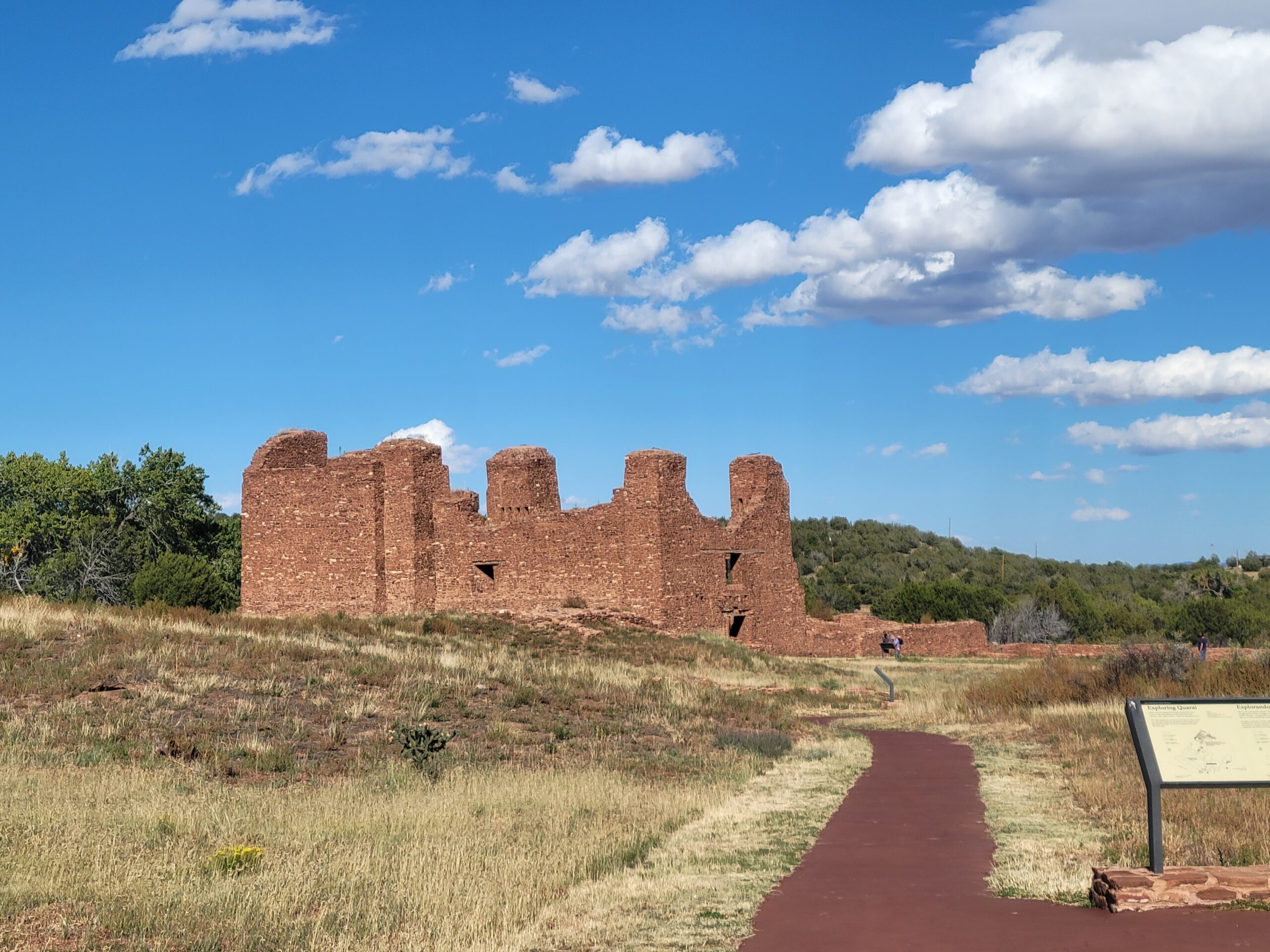We explored the ancient fortified ruins complex of Quarai, ten miles northwest of Mountainair off Highway 60. The Quarai State Monument preserves the old mission, which is in remarkable shape, considering that it is several hundred years old. This impressive and imposing structure below was once part of the Salinas Pueblo Missions of central New Mexico, of which Gran Quivira and Abo are also parts.


The Quarai people were of the Southern Tiwa Pueblo Native Americans. They settled this area around 1250 AD and built pueblos. These pueblos are now indicated by mounds around the mission ruins, where they have become buried with time.

In the 1540s, Spanish conquistadores toured New Mexico but did not mentioned the Salinas pueblos in any of the their records, suggesting they may not have discovered them. Fray Alonso de Peinado began to convert the Salinas Pueblos in 1610 and established a mission church in Chillili, but it is not known if he ever went to Quarai.
In 1626, Spanish missionaries officially arrived in Quarai and were welcomed into the pueblo complex. They called the Tiwa people Cuarac, which has become distorted to Quarai.
The Spanish and Tiwa constructed the Nuestra Señora de la Purísima Concepción de Quarai out of red sandstone and adobe, in the shape of the Latin cross. Remains of an earlier church have also been found on the site, but little is known about it. It is thought that it may have been an early mission effort by Fray Alonso de Peinado.
The Spanish and Tiwa co-existed and engaged in agriculture in this fertile area for many decades. The population of Quarai reached 658 in 1641; it was 1580 in nearby Abo.


These impressive walls were up to 40 feet high and 3-6 feet thick. At their base they can be up to 10 feet thick. Even now that the roof is gone and the floor is sand and crabgrass, the walls keep the interior fairly temperate.


Beside the walls of the missions are the walls of convento rooms surrounding a central plaza, constructed for monks and laybrothers. One of these rooms contains a Native American kiva that was built at the same time as the church and rooms. This suggests that the Spanish missionaries and Tiwa found a way to harmoniously blend their unique religious ceremonies together.
At least six different priests administered at the Quarai site. All of these men reported to the Inquisition in Mexico. They maintained law and order per the Catholic church, and submitted reports of witchcraft in New Mexico.
They also exploited the pueblo people, forcing them to tend to cattle and sheep for them and reserve the best food for them. Don Juan Onate made this possible by forcing pueblo Natives to sign a treaty of subordinance to the Spanish crown in the 1500s, which the pueblo people resented. This led to a revolt around 1680, but by then, Quarai was already gone.
A severe drought, continuous Apache attacks, and increasing unrest with the Spanish government withered the community of Quarai. By 1675, the mission community crumpled and survivors fled to the fertile banks of the Rio Grande, south of present-day Albuquerque. The Quarai site was abandoned and began to crumble.
Then Juan and Miguel Lucero, Spanish ranchers, re-discovered it in 1820s. They turned the area into a sheep ranch, using the convento ruins for pens, and they built their home on a mound that covers an ancient Native American pueblo. They built a church on another mound. Several ranchers joined them in this area, relying on the nearby creek for sustenance. They were finally driven away from the area in 1830 when a fierce Apache raid killed many of them and destroyed the roof of their church. The intrepid Luceros returned in the 1840s and constructed a torreon to protect themselves from the Apaches, but they gave up on the land for some reason shortly after and it changed hands several times until 1913.
J.P. Dunlavy, W.M. McCoy and J.W. Corbett of Mountainair donated the site to the State of New Mexico in 1913. Dr. Erik Reed, a scholar on the area and its history, began advocating for it to become a historical monument, alongside the Abo and Gran Quivira mission sites nearby. By the 1930s, it was a state monument, and then the national park system took over its administration in the 80s. The NPS still runs it today. It is open to the public for free. Some archeological digs have occurred here, though a majority of the ancient Tiwa village is still buried under mounds of dirt and grass.

The Mission Loop Trail tours the ruins and then leads back into some pretty area along a creek that once watered this area.



Rich vegetation, huge trees, and berry thickets made me feel like I had left New Mexico temporarily.

The weather in this area could not have been more perfect that day….I really do think that October is the absolute best month in New Mexico. None of the spring winds, none of the summer heat, just blue skies as far as the eye can see.

It was late October and we had just gotten done with the Pumpkin Chunkin in Estancia when we came this way. So the aspens in the Monzanos and some of the trees near Quarai Ruins were incredible with bright pops of yellow and crimson.

Here we enjoyed a picnic under the shade of this massive fairytale tree. This concluded our adventure, but I plan to go back and tour Abo and Gran Quivira as well!
Sources
www.npshistory.com/publications/sapu/proposal.pdf
http://www.npshistory.com/publications/sapu/ep-v78n4-1973.pdf
http://npshistory.com/publications/sapu/quarai-history.htm
https://www.nps.gov/sapu/learn/historyculture/torreon.htm
Quarai Mission & Pueblo, New Mexico
https://en.wikipedia.org/wiki/Quarai
